The iPhone SE Review
by Brandon Chester on May 16, 2016 8:00 AM EST- Posted in
- Smartphones
- Apple
- Mobile
- iPhone
- iPhone SE
System Performance
With the iPhone SE I've decided to make the transition to our 2016 benchmark suite. We've been including some of these for a little while now, and some tests from our previous suite are still around. There is one test omitted, which is Basemark ES / Basemark Metal, which we'll be deploying once we have all the data from this year's flagship Android smartphones. Comparisons to those Android phones will also have to wait until their respective reviews, and for now I can only really compare the iPhone SE to Apple's other iPhones along with 2015's flagship Android devices.
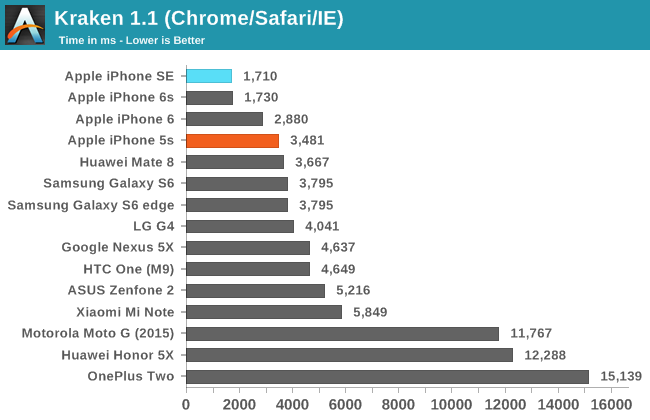
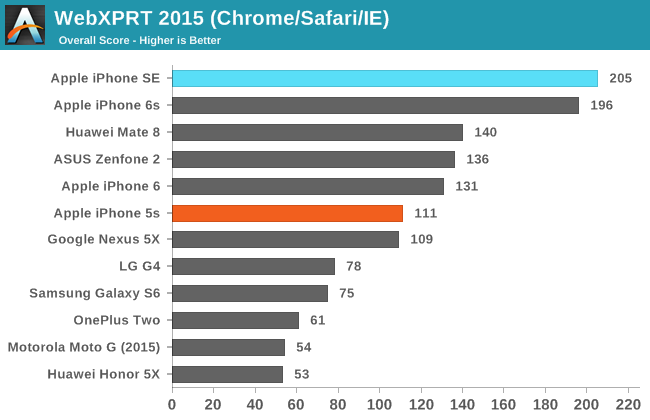
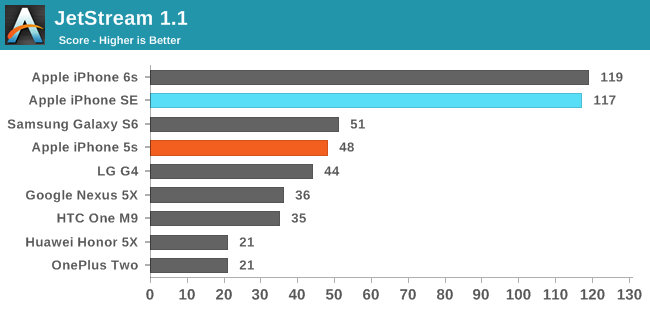
At this point I think we're ready to move to our 2016 web browser benchmarks. Octane is now retired, as there's a large degree of overlap between it and JetStream, with JetStream using a more sensible methodology with measurements for tests like the mandreel-latency test. Kraken, Octane, and Jetstream all have some overlap, but Kraken and JetStream are different enough to make it worth keeping Kraken on. Finally there's WebXPRT 2015, which we already introduced as a replacement for WebXPRT 2013 some time ago.
As expected, the iPhone SE matches the iPhone 6s in our JavaScript tests. The improvement over the iPhone 5s is significant, with roughly double the performance in all cases. This is right in line with Apple's 2x performance claim, and it's important to note that these are updated iPhone 5s figures run on iOS 9 to ensure that it also benefits from the improvements made to Apple's Nitro JavaScript engine since it launched in 2013.
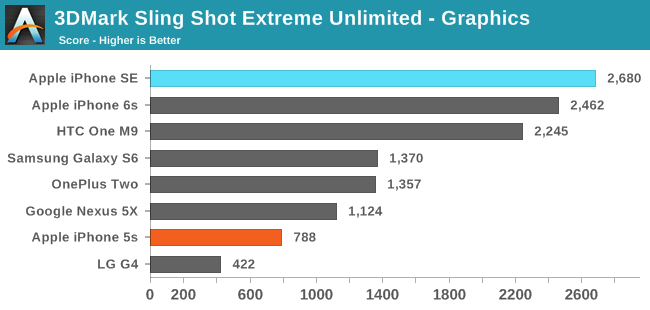
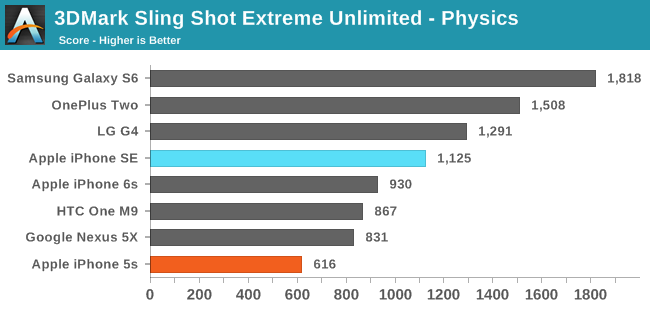
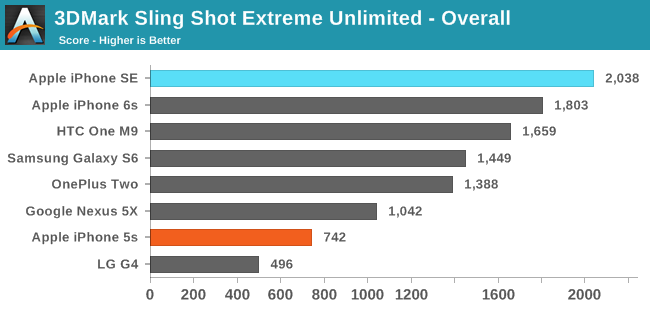
We originally planned to use 3DMark Sling Shot Unlimited, which is an OpenGL ES 3.0 test that runs off screen 1920 x 1080 tests to produce results that are useful for comparing devices and SoCs. However, in the interest of test longevity we have moved to the even newer Sling Shot Extreme test, which uses OpenGL ES 3.1 on Android and Metal on iOS, with a Vulkan version coming to Android in the future. The tests in Sling Shot Extreme render off screen at 2560 x 1440, so it should be a good target for GPU performance well into the future.
In this test the iPhone SE performs well. I experienced a strange situation where the iPhone 6s would consistently score lower than the SE, and I'm not sure if this is due to driver differences or some other problem, but in any case the SE and the 6s both end up at the top of the chart, and the final score is nearly three times higher than that of the iPhone 5s. I'm still waiting on final reviews for this year's Android flagships, so comparisons to Snapdragon 820 and Exynos 8890 will have to wait a bit longer.
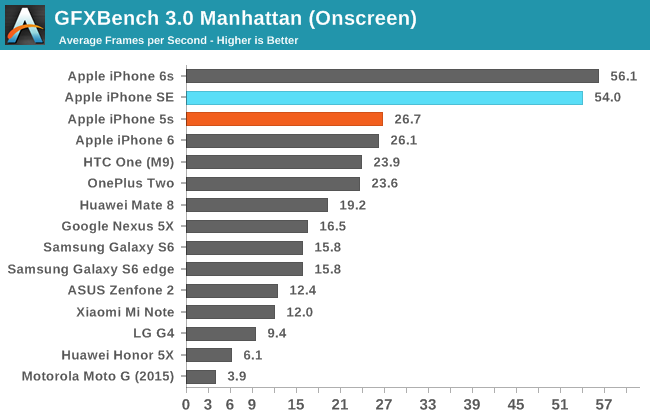
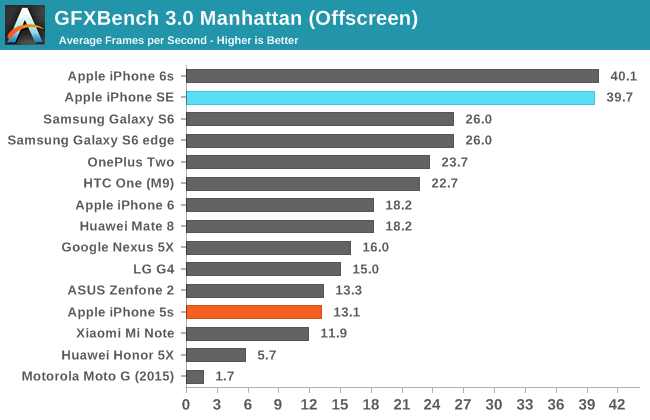
With T-Rex HD being such an old test, I've decided to retire it except perhaps for reviews of devices with relatively slow SoCs. That leaves GFXBench 3.0 Manhattan, and hopefully GFXBench 4.0 in the near future. In Manhattan the iPhone SE performs exceptionally well, achieving a frame rate that is ever so slightly more than three times that of the iPhone 5s. While there's obviously a degree of variance, I think this shows that Apple's 3x GPU performance claim is not an exaggeration, and on such a tiny display with a relatively low resolution you can render a scene like Manhattan at native resolution and almost achieve 60fps.
NAND Performance
With the first generation of the MacBook, Apple introduced their own PCI-E SSD controller with support for NVMe. At the launch of the iPhone 6s and iPad Pro, they noted that both devices had significantly improved storage performance. During the course of our review we discovered that Apple had essentially brought some version of their controller down to their mobile devices, and as a result they led the rest of the mobile market by a large margin when it came to overall storage performance.
With the iPhone SE, Apple uses the same controller as they do in the iPhone 6s and iPad Pro. Since this iPhone is a 64GB unit, we can take a look at the potential impact of a smaller SSD that may not be able to utilize parallelism to achieve the same performance as its 128GB and 256GB counterparts in Apple's other devices. To analyze the storage performance of the iPhone SE I've used StorageBench, a NAND benchmark developed by Eric Patno which is comparable to our AndroBench 3.6 test on Android.

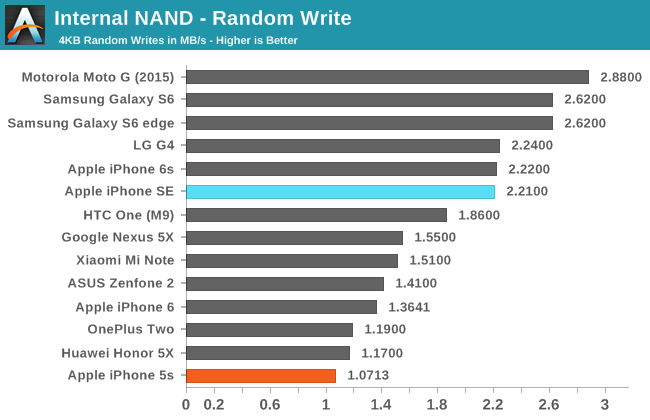
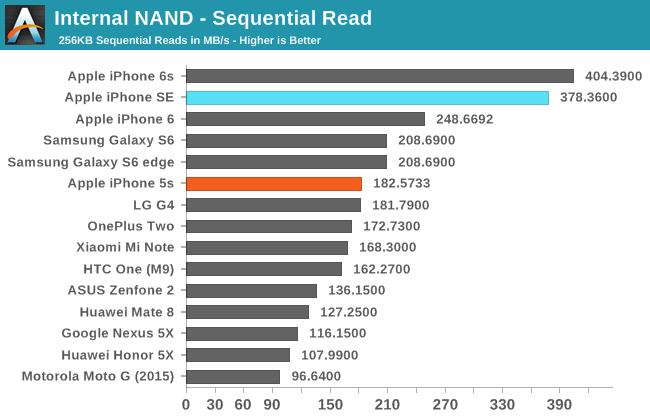
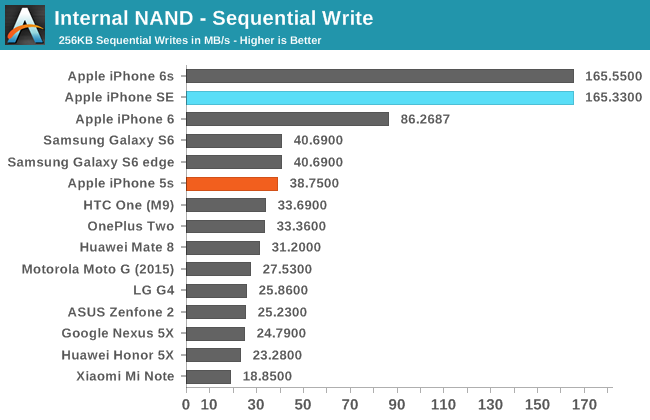
Despite the fact that the storage capacity is half that of our iPhone 6s review unit, the iPhone SE performs essentially just as well. Random reads actually end up being faster, while random writes are nearly identical. Sequential reads trail the 6s by a bit, but sequential writes end up being identical much like random writes. The differences are enough to attribute to testing variance, and it's probably safe to say that the storage performance on the 64GB iPhone SE is identical to that of the 64GB and 128GB models of the iPhone 6s.










138 Comments
View All Comments
Impulses - Monday, May 16, 2016 - link
Ehh, there's other places you can place a fingerprint sensor and have it be just as effective... The on screen button argument is valid tho, but it's kind of subjective... For video, where they hide away, they're a better choice, for general use it's less advantageous, etc.The biggest rationale for a physical home button continues to be that it allows you to easily wake up the phone while it lays flat, IMO... Though tricks like the "knock on" pioneered by LG can offer an alternative to that.
Let's be honest tho, Apple AND Samsung probably just stick to their guns on the buttons at this point as a sign of pride and/or because it's a recognisable design. They sued the stuffing out of each other in large part over the button and how it ties the design together!
name99 - Monday, May 16, 2016 - link
I suspect the way Apple gets away from the home button (and the area it consumes) is by copying ideas from the Apple Watch.IF they can get ultrasound based fingerprint detection to work well (so that it can work anywhere on the screen) that's REALLY helpful in terms of making the various lockscreen swipes work so much better --- right now it's kinda lame that you swipe on a notification or text message or whatever but then have to go through the unlock screen.
So if they can solve the "no need for a fingerprint button" problem, then, IMHO, the logical way to move forward is to adopt ideas from the Apple Watch. These ideas could include (along with screen lights up on orientation) having a crown sticking out the side of the phone. I don't know how well that would work --- maybe it would be too fragile? --- but it seems like it could be useful in a number of ways, and the sort of UI element that Apple could (at least attempt to) patent the hell out of and fairly aggressively and accurately claim that no-one had done anything like that until they implemented it. If you had a crown like button, apart from the rotating to scroll like on the watch, it could also (like on the watch) act to
- light up the screen
- bring up springboard
- bring up Siri
- bring up the list of previous apps (on watch, at least right now, just the last app) used.
Doing something like this would allow the iPhone to kinda reset. Apple could get off the naming treadmill (so like Macs new ones get released when they are ready, and have names like "iPhone late 2018"), and even change other things they might want to change (maybe it's worth actually switching to USB-C?). Like I said, a reset allows for lotsa things to change all at once, and allows the inevitable bitching and "I'll never buy an Apple product again" idiocy to flame out over one glorious three month period of non-stop internet ranting.
Ratman6161 - Wednesday, May 18, 2016 - link
"So if they can solve the "no need for a fingerprint button" problem". Well, on my Galaxy Note 5 fingerprint recognition works great. And it has a button too. And the ratio of overall size to screen size is better too. All it took to do that was to have an oblong button instead of a big round one. What's the big deal.Ratman6161 - Monday, May 16, 2016 - link
I guess I'll have to hold an SE in my hand to see how they feel relatively speaking. But 12.4 mm Vs 12.7 mm = a difference of .3 mm in height. Same math, .6 mm different width and .13 mm in thickness. From the numbers, its hard for me to visualize there being any significant difference in real world feel. And 4.2 is still > than 4.0, though I guess it all depends on what's important to you.To me, overall the form factor seems essentially the same and as with all these endless debates, in the real world it comes down to personal preference.
name99 - Monday, May 16, 2016 - link
I use both (6 vs 5) frequently. The difference in height, and the difference in edge curvature, are both noticeable, but I would not call one worse or better than the other (though I suspect the width of the 6 with hard edges would be noticeably unpleasant).For me at least, as a guy with big enough pockets and hands, Apple made the right call with the size of the 6. I remain curious as to whether the primary draw of the SE if the smaller screen size (or, more precisely, the smaller area for pockets and handbags) or the lower price --- I've never seen anything definitive either way.
qap - Tuesday, May 17, 2016 - link
Thickness stopped being a limiting factor (for users, not for designers) some time ago. Thicker phone can even be more comfortable in hand. So there is no point in comparing volumes.That leaves footprint and 10% difference means they are direct competitors. In fact (as an example) I am thinking about buying one of them as they are closest to my ideal phone.
Iphone SE is perhaps closer, but display and everything about display is really off-putting. You can fit 4,5" in the same footprint. Even 4,3" and it would be in my pocket already (it can be done - you can look at galaxy s4 mini). But 60% screen-to-body in 2016? And by 2016 standards it's not even a good display (low res, poor blacks).
Eden-K121D - Monday, May 16, 2016 - link
They didn't even post a S7 review part-2 which was released much earlier than the iPhone SE yet the SE review comes first.Yawn. It has nothing new.michael2k - Monday, May 16, 2016 - link
The review they did was sufficient to show you how much faster the SE is than the S7:http://www.anandtech.com/show/10120/the-samsung-ga...
Impulses - Monday, May 16, 2016 - link
Different writers tho, IIRC, not that it's an excuse but it's not like they're purposely prioritizing the SE.whiteiphoneproblems - Monday, May 16, 2016 - link
I love mine! Only (minor) issues are a rattling power button, and a funky auto-brightness that doesn't like turning on to lowest setting in a dark room (never had that problem in an iPhone before).